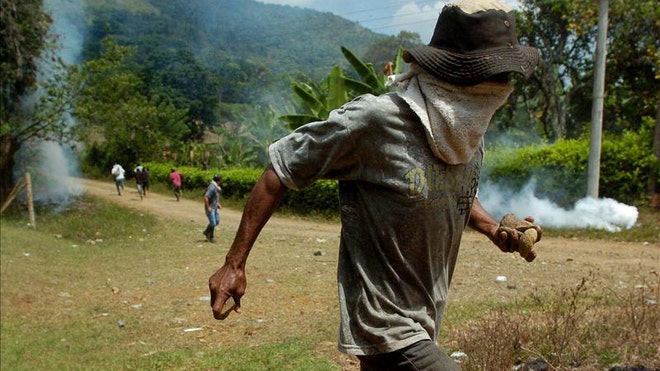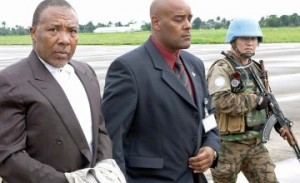By Margaret Janelle Hutchinson
Impunity Watch Reporter, South America
BOGOTA, Colombia – Four Nasa Indians who had taken up arms with the Revolutionary Armed Forces of Colombia, or FARC appeared before a group of roughly 1,000 elders and residents of Nasa reserves in the embattled southwestern province of Cauca over the weekend. The defendants, one minor and three adults, were convicted of attacking civilians and disrupting the “harmony” of the community. The minor was sentenced to 10 lashes and each adult received 30 lashes.

Watch: FARC rebels flogged by Colombian tribe. (Video Courtesy of Al Jazeera)
The trial, part of a push by the indigenous tribe to get both FARC rebels and government forces off their land, is lawful under Colombia’s 1991 constitution, which promises autonomy to the nation’s 102 indigenous ethnic groups.
The Nasa, also known as the Paez, do not consider the sentence to be a “punishment”, but rather see the flogging as a “solution” that allows the defendants to restore balance to their relationship with the community and with their spirit.
Marcos Yule, the governor of the Toribio reservation, explained that the solutions that are normally imposed under the indigenous law are the “cepo,” a wooden structure that presses on the legs or hands, temporary burial where only the head is above ground, the “whip to beat the illness, counseling and even … exile.”
The four FARC fighters were whipped on the lower half of their bodies, causing serious wounds on the backs of their legs that were treated by community medics.
“The adults received the 30 (lashes) but the minor could not take the 10 and it was lowered to half that, because … he is 16,” Yule said.
The four had been held since last Wednesday, when members of the Nasa Indigenous Guard apprehended them in the mountains near Toribio with rifles and explosives.
The trial is the latest chapter in Colombia’s half-century old internal struggle.
Many Colombians have felt far removed from the armed conflict between the government and the FARC. In truth, much of the violence plays out in remote regions, having the greatest impact on the most marginalized members of society.
At least 33 indigenous people have been murdered this year in Colombia, compared with 118 in all of 2011 with Nasa Indians of the southwestern province of Cauca accounting for the largest number of fatalities.
When Nasa Indians stormed a military communications base in the southwest province of Cauca late last week, the reality of the fighting was again brought to the forefront.
President Juan Manuel Santos, feeling the political ramifications of the Nasa’s actions, alleges that some of the 115,000 Nasa are allied with rebels of the leftist FARC, which authorities say purchases the high-quality marijuana that many indigenous grow. On July 18, President Santos released an intercepted email supposedly written in May by a local FARC commander, which called for the “spread of propaganda in the municipalities of northern Cauca so that locals demand the withdrawal of security forces.”
Contradicting the government’s characterization of the protestors is the fact that they seem to be staying true to their stated desire to rid Toribio of all armed actors, legal or not. In addition to the recent trial and sentencing of the four FARC rebels, demonstrators claim to have dismantled a FARC campsite in the area.
For further information, please see:
Fox News Latino – Indigenous Leader Slain in Colombia – 24 July 2012
In Sight – Questioning Ties Between Colombia Indigenous and FARC Rebels – 23 July 2012
Al Jazeera – ‘FARC rebels’ flogged by Colombian tribe – 22 July 2012
Fox News Latino – Colombian Indigenous Court Sentences Rebels to Flogging – 22 July 2012
The Miami Herald – Indian upheaval bares Colombia’s nagging conflict – 21 July 2012


